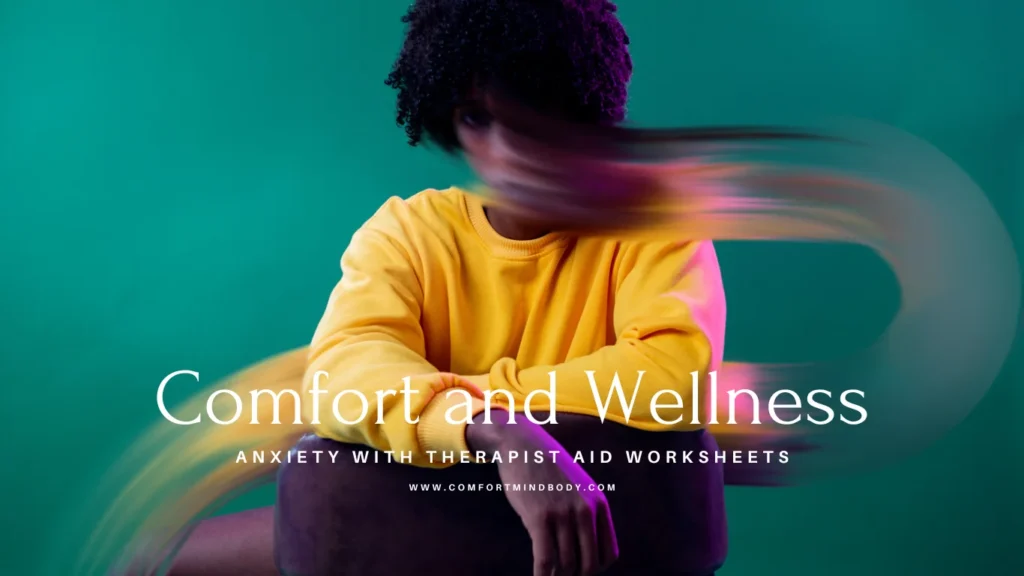Table of Contents
ToggleTherapist Aid in Challenging Anxious Thoughts
Therapist Aid in Challenging Anxious Thoughts. Anxious thoughts can be likened to an unwelcome houseguest. They barge in uninvited, make you uncomfortable, and are hard to kick out.
Understanding anxious thoughts is the first step towards gaining control over them. Anxious thoughts are those nagging worries that persist even when there is no immediate threat. They are often too strong for the situation. This can be harmful and may lead to anxiety disorders if not handled well.
Anxiety is a normal reaction to stress or danger. In small amounts, it can help you stay alert and focused. When anxiety is always present or too strong, it can impact your relationships and daily activities. This is when it turns into an anxiety disorder. These disorders can be crippling, but with understanding, patience, and the right techniques, they are manageable.
Understanding anxious thoughts involves recognizing their irrationality and the physical responses they induce. Anxious thoughts trigger the body’s fight or flight response, causing symptoms like rapid heartbeat, dry mouth, or an upset stomach.
Understanding this link between mind and body is crucial in the path towards managing such thoughts.
What are Cognitive Distortions?
Therapist Aid in Challenging Anxious Thoughts
Cognitive distortions are irrational thoughts and beliefs that we unconsciously reinforce over time. These patterns of thought are often inaccurate and negatively biased. Cognitive distortions can harm your mental health. They can lead to anxiety, depression, and other mental health issues.
There are several types of cognitive distortions, including overgeneralization, black-and-white thinking, catastrophizing, and personalization. Overgeneralization involves drawing broad conclusions from a single event or piece of evidence.
Black-and-white thinking, also known as all-or-nothing thinking, is when we view things in absolute, extreme terms. Catastrophizing involves anticipating the worst possible outcome to a situation. Lastly, personalization is blaming oneself for events outside of one’s control.
A cognitive distortion therapist aid can be instrumental in helping individuals recognize and challenge these distorted thoughts. Therapists can use techniques like cognitive-behavioral therapy (CBT) to help people change their thoughts. They can replace negative thoughts with more accurate and rational ones.
Importance of Challenging Anxious Thoughts
Challenging anxious thoughts is a critical step towards overcoming anxiety. By identifying and challenging these thoughts, we can reduce anxiety and increase our ability to handle stress. Moreover, challenging anxious thoughts allows us to understand our fears better, which is key to overcoming them.
Challenging anxious thoughts also helps us to gain control over our emotions. When we let anxious thoughts run rampant, they control us. However, by challenging these thoughts, we empower ourselves. We can choose how we react to anxiety-inducing situations and manage our responses effectively.
Lastly, challenging anxious thoughts can improve our overall mental health. Anxiety can lead to other mental health problems, such as depression and panic disorders. By tackling anxious thoughts head-on, we can prevent these issues from developing or worsening.
How to Identify Anxious Thoughts
Therapist Aid in Challenging Anxious Thoughts
Identifying anxious thoughts is the first step towards challenging them. These thoughts often appear as automatic negative thoughts (ANTs). They are quick and usually uncontrollable thoughts that happen after a trigger. These thoughts often contain cognitive distortions, are usually negative, and can increase feelings of anxiety.
To identify anxious thoughts, one needs to be aware of their thought patterns and emotional responses. This involves being mindful and taking a step back when faced with a trigger, then carefully examining the thoughts that arise. It’s important to note that these thoughts are not facts but merely interpretations of the situation.
Another effective way to identify anxious thoughts is by journaling. Writing down your thoughts and feelings can help you see patterns and triggers. This makes it easier to identify and challenge those thoughts. A therapist’s aid can be instrumental in this process, providing guidance and support along the way.
Strategies for Challenging Negative Thoughts
Therapist Aid in Challenging Anxious Thoughts
There are several strategies for challenging negative thoughts. One of the most effective is cognitive restructuring, a key element of cognitive-behavioral therapy. This involves identifying and challenging irrational thoughts and replacing them with more rational ones.
Another strategy is to use positive affirmations. These are positive statements that can help to challenge and overcome self-sabotaging and negative thoughts. When you repeatedly tell yourself something positive, you start to believe it, which can help to reduce anxiety.
Mindfulness is another effective strategy for challenging negative thoughts. This involves staying present and non-judgmental, observing thoughts and feelings without trying to change them. This practice can help to reduce anxiety and increase feelings of calm.
Role of a Therapist Aid in Managing Anxiety
Therapist Aid in Challenging Anxious Thoughts
A therapist’s aid plays a critical role in managing anxiety. They can provide support, guidance, and tools necessary to help individuals understand and challenge their anxious thoughts. Therapist aids use strategies such as cognitive-behavioral therapy, mindfulness, and other techniques to help individuals manage their anxiety effectively.
Therapist aids can provide resources like worksheets for intrusive thoughts. These worksheets help identify and challenge anxious thoughts. These worksheets include exercises that help people understand their triggers. They also help track thought patterns and develop coping strategies.
Additionally, a therapist’s aid can provide a safe and supportive environment for individuals to express their fears and concerns. They can provide support, understanding, and helpful advice. This helps people face their fears and take charge of their lives again.
Tools for Therapist Aid: Intrusive Thoughts Worksheet
Therapist Aid in Challenging Anxious Thoughts
Intrusive thoughts worksheets are valuable tools for therapist aids in managing anxiety. These worksheets help individuals to identify their triggers, track their thought patterns, and develop effective coping strategies.
They often include exercises that encourage individuals to challenge their cognitive distortions and replace them with more rational thoughts.
One example of this type of worksheet is the “Thought Record Sheet.” This sheet helps people write down their anxious thoughts. It also helps them find the errors in these thoughts and create rational responses. Another example is the “Fear Ladder.”
This tool helps people face their fears step by step. It involves making a list of scary situations. Then, individuals slowly expose themselves to these situations.
These worksheets can be used with therapy sessions. They give people practical tools to manage their anxiety outside of therapy.
How to Stop Worrying About Things You Can't Control
Therapist Aid in Challenging Anxious Thoughts
Worrying about things we can’t control is a common cause of anxiety. However, it’s important to remember that worrying is not productive. It doesn’t solve problems or prevent bad things from happening—it only increases anxiety.
One way to stop worrying about things you can’t control is by practicing mindfulness. This involves staying present and focused, rather than dwelling on the past or worrying about the future. Mindfulness can help to reduce anxiety and increase feelings of calm.
Another strategy is to focus on what you can control. You can’t control external events, but you can control your reaction to them. By focusing on your reaction, rather than the event itself, you can reduce anxiety and feel more empowered.
Lastly, it’s important to accept uncertainty. Uncertainty is a part of life, and we can’t predict or control everything. By accepting this, we can reduce anxiety and live more fully in the present.
How to Stop Worrying About Everything: Practical Steps
Therapist Aid in Challenging Anxious Thoughts
To stop worrying about everything, it’s important to practice self-care.
- This means eating healthy foods.
- It also means exercising often.
- Getting enough sleep is important.
- You should take time each day to relax and enjoy something.
These actions can reduce anxiety and improve your overall well-being.
Another practical step is to challenge your worries. Ask yourself if your worries are rational, or if they’re based on fear and anxiety. If it’s the latter, try to replace these worries with more rational thoughts.
Lastly, seek support. This could be from a therapist, a support group, or loved ones. Talking about your worries can help to reduce them, and others may be able to provide perspective or advice.
Anxiety is a normal human reaction to stress. It is the body’s natural defense mechanism, preparing us to face or flee from danger. Anxiety can sometimes be too strong or not appropriate for the situation. When this happens, it can interfere with daily life. This can lead to mental health problems.
Real-life Examples of Challenging Anxious Thoughts
Therapist Aid in Challenging Anxious Thoughts
There are several real-life examples of challenging anxious thoughts. For instance, consider a person who is anxious about public speaking. They may have thoughts like “I’m going to mess up” or “Everyone is going to laugh at me.” These are examples of cognitive distortions—specifically, catastrophizing and mind-reading.
To challenge these thoughts, the individual can use cognitive restructuring. They can ask themselves two questions:
- “Am I likely to mess up?”
- “If I make a mistake, will people laugh at me?”
By answering these questions, they can think more clearly. For example, they might say, “I’ve practiced my speech, so I probably won’t mess up.” They could also think, “Even if I make a mistake, it’s not the end of the world.”
People understand that everyone makes mistakes.”
Another example is a person who is anxious about their health. They may have thoughts like “I have a headache. It must be a brain tumor.” This is an example of catastrophizing. To challenge this thought, a person can ask, “Is it likely that a headache means a brain tumor?
Or is it more likely that I’m just stressed or dehydrated?” By answering this question, they can think more clearly. For example, they might say, “My headache is probably from stress or dehydration.” If it persists, I’ll see a doctor.”
Conclusion: Triumph Over Fear with Therapist Aid
Therapist Aid in Challenging Anxious Thoughts
Triumphing over fear with the aid of a therapist is a journey. It involves understanding anxious thoughts, identifying cognitive distortions, and learning to challenge these thoughts.
Using the right tools can help reduce anxiety. For example, intrusive thoughts worksheets can be useful. Strategies like cognitive restructuring and mindfulness are also effective.
Remember, it’s okay to seek help. A therapist’s aid can provide invaluable support and guidance along this journey. They can help you understand and challenge your anxious thoughts. They provide tools and strategies to manage your anxiety well.
So don’t let fear hold you back. With understanding, courage, and the right help, you can triumph over fear and live a life free from the shackles of anxiety.
Unique Meditation Techniques for Anxiety Management
Therapist Aid in Challenging Anxious Thoughts
Anxiety is a normal human reaction to stress. It is the body’s natural defense mechanism, preparing us to face or flee from danger. Anxiety can sometimes be too strong or not appropriate for the situation. When this happens, it can interfere with daily life. It may also lead to mental health problems.
Affiliate Disclosure:
The links contained in this product review may result in a small commission. This goes towards supporting our research and editorial team and please know we only recommend high-quality products.
Note: This article is for informational purposes only and is not intended to diagnose, treat, or cure any disease. Always consult a healthcare professional before taking any supplement or making any changes to your diet or lifestyle.
Resources:
Therapist Aid in Challenging Anxious Thoughts
- American Psychological Association (APA): The APA provides a wide range of resources for both mental health professionals and the public. Website: apa.org
- National Alliance on Mental Illness (NAMI): NAMI offers support and education for individuals and families dealing with mental illness. Website: nami.org
- Mental Health America (MHA): MHA provides resources and tools for individuals seeking help with mental health issues. Website: mhanational.org
- Substance Abuse and Mental Health Services Administration (SAMHSA): SAMHSA offers resources on substance abuse and mental health. Website: samhsa.gov
- Psychology Today: Psychology Today has a therapist directory and many articles on mental health topics. Website: psychologytoday.com
- GoodTherapy: GoodTherapy has a therapist directory and resources on various therapy topics. Website: goodtherapy.org
- Therapy Aid: Therapy Aid provides free, evidence-based mental health worksheets and resources. Website: therapyaid.com
- Therapist Aid: Therapist Aid offers free worksheets, tools, and resources for mental health professionals. Website: therapistaid.com
- Centre for Clinical Interventions (CCI): CCI provides free self-help resources and workbooks on various mental health topics. Website: cci.health.wa.gov.au
- Mind: Mind provides information and support on mental health topics. Website: mind.org.uk






